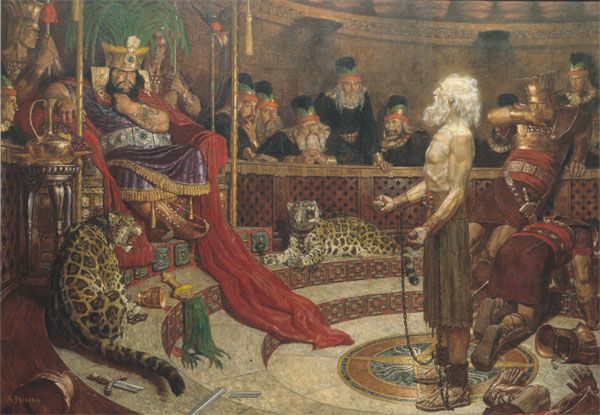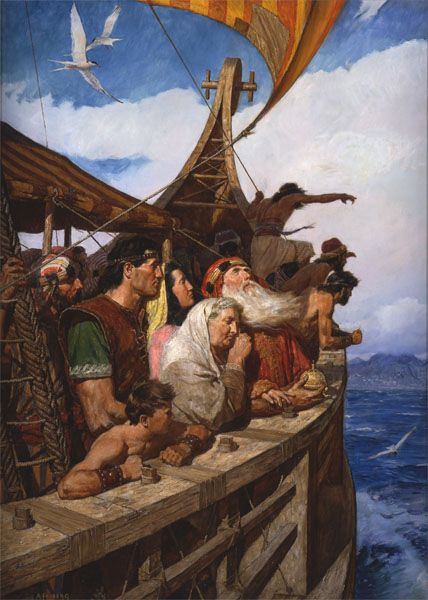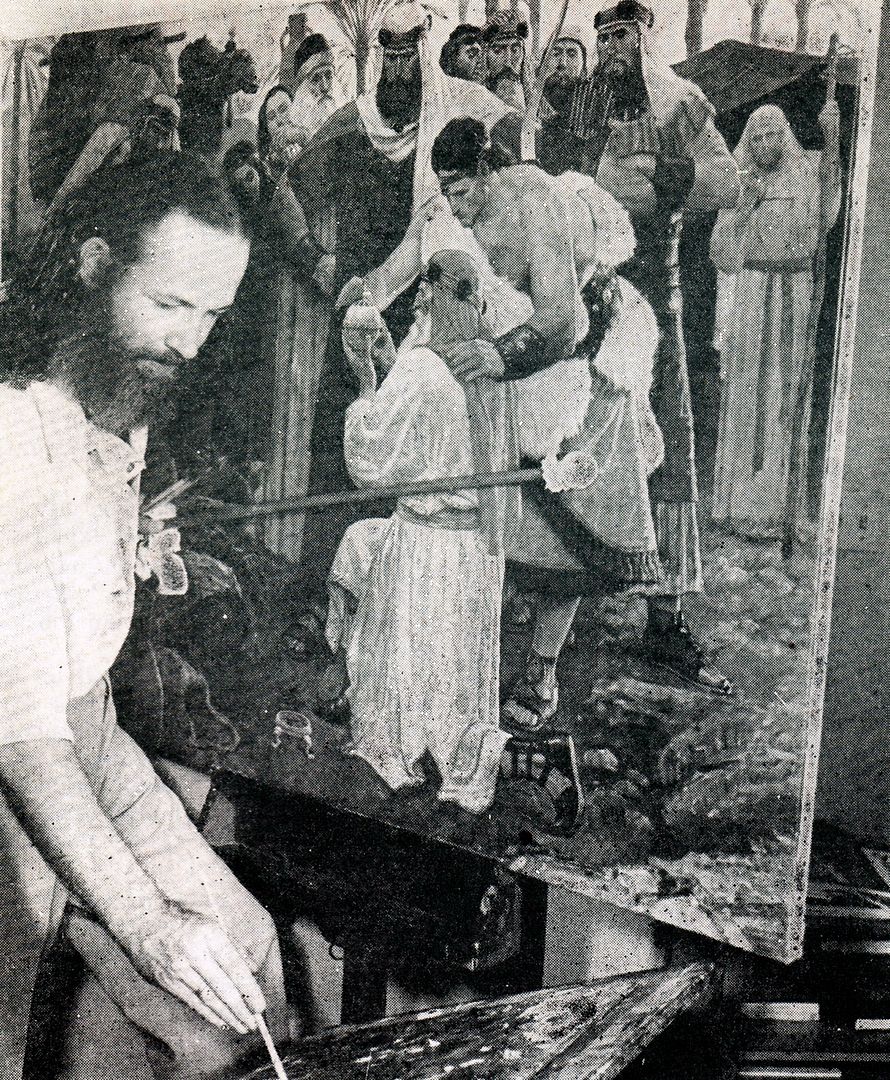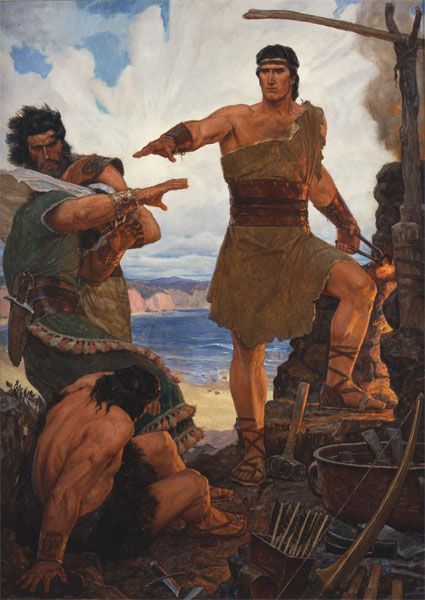If many of us smile when the art of Arnold Friberg is mentioned, it’s because we’re no doubt thinking of a certain commonality among his artworks: His characters, whether they be teenagers newly called to military duty, or seasoned warriors in the prime of life, or aged prophets, or young women exiting the waters of baptism – or even chickens – share a certain, how shall we say it? robustness of form. Sometimes because that’s the first thing we’ve conditioned ourselves to see, it’s also all we see.
I’ve recently run across a report made by Friberg himself in 1952, just before those iconic Book of Mormon paintings were debuted, one each month, in the 1953 issues of The Children’s Friend, which helps me appreciate a little more about them than the fine musculature of the human – or chicken – form.
 Friberg understood that he was an illustrator in the service of the text, not acting in this case as a capital-A Artist. That is, his duty was “to suggest to the reader some of the rich experiences that might be his through reading the particular story or book that is being illustrated.” In the case of his painting of Abinadi before King Noah, for example, his goal was to depict a certain, specific incident from the text, not to paint a fine arts archetypal image of truth speaking to power, nor a universal symbol of majesty in chains. This was Abinadi and King Noah, nothing less and nothing more.
Friberg understood that he was an illustrator in the service of the text, not acting in this case as a capital-A Artist. That is, his duty was “to suggest to the reader some of the rich experiences that might be his through reading the particular story or book that is being illustrated.” In the case of his painting of Abinadi before King Noah, for example, his goal was to depict a certain, specific incident from the text, not to paint a fine arts archetypal image of truth speaking to power, nor a universal symbol of majesty in chains. This was Abinadi and King Noah, nothing less and nothing more.
Although he was illustrating a specific text, he acknowledged his need to invent visual details that were not noted in the text.
First, it was necessary to consider some baffling questions: Did the Nephites wear beards? What was the true appearance of Nephi’s ship, or of the Liahona? What did Abinadi and Mormon and Captain Moroni look like? Admittedly it is difficult, even impossible, to resolve these questions with any finality.
Now, a writer can simply allude to, or leave unsaid, anything specific of which he is not sure. For instance, he need not mention whether or not a man had a beard. But the illustrator has to paint something. The pictured character either will have a beard or will not have a beard. If he has one it will be black or red or brown or grey, and it will be long or trimmed in some fashion. And his armor has to be formed in a certain way and of some specific material. The illustrator cannot evade the issue.
With specific reference to invented details in that picture of Abinadi and King Noah, he wrote:
In the picture of Abinadi at King Noah’s court, it seemed that a pair of jaguars leashed to the throne would enhance the feeling of a royal palace. Also, since animals are said to be responsive to extra-sensory forces, their snarling fear of Abinadi, along with the down-draft of smoke from the braziers, tends to heighten the feeling of a more-than-earthly power at work.
 Ditto with the picture of Lehi holding the Liahona – have you ever noticed the little footed ring on the ground there?
Ditto with the picture of Lehi holding the Liahona – have you ever noticed the little footed ring on the ground there?
In picturing the Liahona itself, I tried to produce a reasonably logical version of how it might have looked; and a tripod was shown for it to rest in, as it probably wouldn’t have been allowed just to roll around on the ground when not in use.
Friberg decided that in the early events of the Book of Mormon narrative, the people and their hair styles and clothing fashions and tools and other details would likely be similar to the Biblical people from whom they came. For later events, he relied on a sense of New World archeology.
So much of the ruins unearthed tends to be from later than Book of Mormon days.
However, there is a certain logic and sequence that can serve as a guide. We know of the strong Hebraic and Egyptian influences, and we see what they later developed into; and actually … there is a strong cultural continuity. By weaving this logic into the bits of descriptive information in the Book itself, it is possible to arrive at a reasonably truthful reconstruction, in both dress and architecture.
His search for realism took him, believe it or not, to Hollywood, whose studios maintain huge libraries of costume detail and research into other aspects of ancient life that have been portrayed on screen.
The movie studios were very helpful in making available research and costumes used in producing Biblical pictures such as “David and Bathsheba” and “Samson and Delilah.” … Before the movie “Samson and Delilah” was produced, the studio spent fourteen years in basic research, covering minutest details of speech, customs, clothing and materials, and such bits of information as whether or not candles had been invented at that time (they had not; only oil cups were burned until in roman times the wax candle as we know it came into use).
This material was all bound into a large volume, and from it the story and dialogue, as well as sets, props, and costumes were developed. Mr. DeMille very kindly let me have a copy of this research volume.
 Friberg searched other sources as well for bits of realism: Did you realize, for instance, that the birds overhead in the scene of Lehi’s people arriving in the New World are not simply generic birds, even generic seabirds? They are roseate terns, “which might logically be found in those waters,” said Friberg (indicating his acceptance of the traditional landing site as the west coast of Chile in the general latitude of Valparaiso). He found living jaguars in a zoo for the Abinadi painting. He searched until he had found enough specific examples of ancient clothing to use in his work:
Friberg searched other sources as well for bits of realism: Did you realize, for instance, that the birds overhead in the scene of Lehi’s people arriving in the New World are not simply generic birds, even generic seabirds? They are roseate terns, “which might logically be found in those waters,” said Friberg (indicating his acceptance of the traditional landing site as the west coast of Chile in the general latitude of Valparaiso). He found living jaguars in a zoo for the Abinadi painting. He searched until he had found enough specific examples of ancient clothing to use in his work:
It took much research to find, for instance, not only one ancient sandal, but enough different styles of ancient sandals to avoid monotony. You will notice in the paintings that people are dressed differently one from another, for probably then as now there was variety even within the styles of the period.
 He even grew a beard and let his hair grow long as he was working on these paintings, to give himself a better understanding – he says – of the men beneath the beards in his paintings.
He even grew a beard and let his hair grow long as he was working on these paintings, to give himself a better understanding – he says – of the men beneath the beards in his paintings.
In the search for realism, not only did I grow long hair and a full beard for study, but a friend, Rudy Christiansen, also grew a head of magnificent long wavy hair for the same purpose. This was sometimes trying for both of us, since the men working in a shop along with Rudy couldn’t resist ribbing him and doing such things as taking up a collection to buy him a haircut and giving him a Mother’s Day gift. A lady even stopped me downtown to say that she had seen me wrestle on television!
.
(And that was in 1952!)
I think the details that impress me most are Friberg’s efforts to remain absolutely true to the text of the Book of Mormon:

In the picture showing the discovery of the Liahona, Nephi has a steel bow on his back; I had to find a steel bow for a model. In the following picture Nephi, about to build his ship, has a wooden bow, having broken the steel one meanwhile.
Friberg considered his work on these illustrations to be a “fine opportunity for service,” and found that “the great personalities who walk through its pages have become alive and real, and of immense stature.” I have been aware of the “immense stature” of those characters as long as I can remember; certainly I have a greater appreciation for his paintings after he pointed out to me these details of his work that I had overlooked.
Continue reading at the original source →



